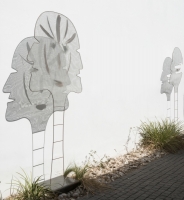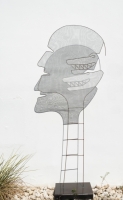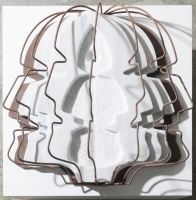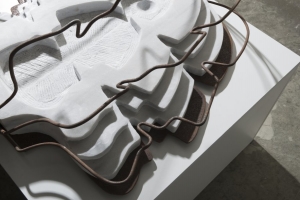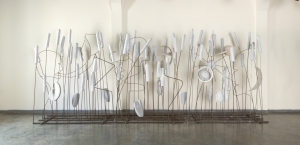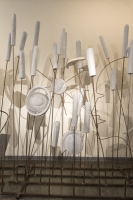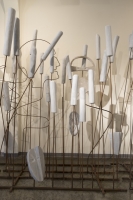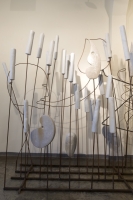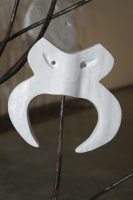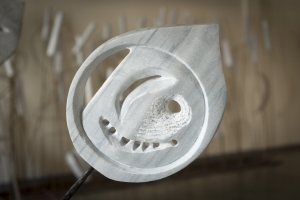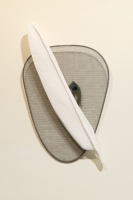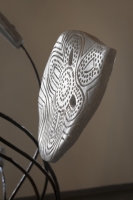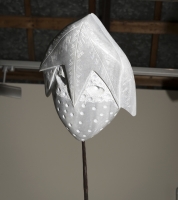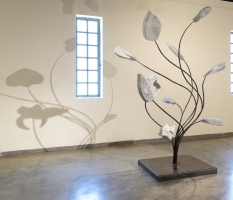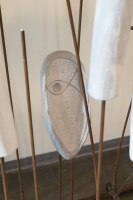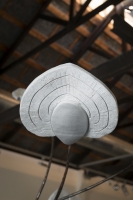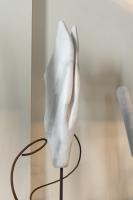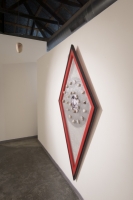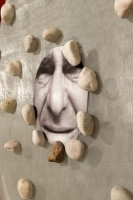Avi Sperber sculpts the masks of his soul / Opening remarks
The new current exhibit of stone sculptures by artist Avi Sperber expresses extraordinary strengths of personal dialog using the language of his work to relate to his own reflection sculpted in unconventional materials. Use of the mask enables him to take a step back, to create a symbolic contour that represents his presence on the ground, a new outline that is rooted in place, but whose energy radiates outward across the boundaries of time and place. The exhibit presents the development of a concept that was inspired by the metamorphosis project and its connection to the work of artist Dennis Oppenheim, who examined the relationship between the element of fear and the face and the mask. Mythical symbols based on the conscious and unconscious in different cultures and motifs relating to the subjects of the personal
“self’ and what exists between the obvious and the obscure, formed the basis for the exhibition’s sculptures.
Avi Sperber’s language of form combines complementary qualities of two-dimensional and three-dimensional sculpture. In the current exhibition he utilizes his broad and epic treatment of the complex idea of the sculpture and creates large scale works that include details of various smaller sculptures, building the general and conceptual outline of his work.
His creative personality as an individual and a sculptor becomes divided into a variety of two-dimensional faces powerfully drawn, and these create types of masks that radiate strength and power on the one hand, while integrating with nature and the environment that surround them, on the other hand.
Avi Sperber is undoubtedly occupied with mass and space, whether embodied in natural forms or represented in his works and his own personal style. His work always strives to create the ideal balance between the slab of stone and the space that envelops it. The worlds of the past and tradition merge into the “here and now” to which he relates, and often criticizes. Avi Sperber’s sculpture, despite the fact that it challenges the traditions of the past and current myths, relates – relevant and timely – to current problems and the experience of Israel’s contemporary reality. The theme of the mask is familiar to us in every aspect of our present lives, as it was in the past, reflecting truth and clear honesty versus concealment, falsity and even duplicity.
Avi Sperber’s sculptures, which are usually made from natural materials, are delimited and defined by their surfaces. The contours and lines of the sculpture serve as meaningful components of expression that help us grasp the statue’s form. Avi Sperber’s masks truly represent the characteristic language of sculpture. He relates to the angles of the stone limitlessly and creates impressive cuts while being always careful of its natural lines and its original lines and colors.
The connection between the stone and the industrial metal and iron produces a powerfully dramatic encounter between natural matter and industrial material.
The new exhibition, which develops Sperber’s creative dialog with the image of the mythical Hermes, who represents the ambiguity of what is present and exists vis-a-vis the hidden and concealed, continues the journey of existential examinations using the language of art that outlines the path of Avi Sperber’s work. In this exhibition there is more than meets the eye, ensuring pure dramatic enjoyment to its visitors who are invited to come discover its treasures.
Doran Polack / Exhibit Curator
The Masks - Avi Sperber
The use of masks is known and widespread in the world, with a great variety of purposes. A mask is used to hide and reveal at one and the same time. It can be used to strengthen a particular identity or to change it; to adopt different characters and personalities or to represent one form of godliness or another.
From time immemorial masks have also been used in forms of worship. The creation of masks which bring with them a ritual metamorphosis are thought of as one of the basic impulses of human nature. In different cultures the mask serves as a tool for the expression of the spiritual connection between man and animal or the gods protecting him. Similarly a mask was used to represent the ancient ancestors of the tribe, in order to benefit from their influence, experience, and wisdom, both in ceremonies, customs, and various day to day needs.
From former days and up to the present it is possible to find masks in healing ceremonies or in the dress of the doctor or the surgeon in the hospital, in the judge’s wig or advocate’s gown, in various graduation ceremonies, in black or white attire at funeral ceremonies and more. Generally, the mask covers the face, because this is the part of the human body that most prominently represents the personality of a person. The mask has the power to change his identity, his age, his social standing, and his general appearance.
The psychologist Jung relates to masks differently. He attached the term “persona” to the everyday face of a mature adult, which presents his preferred self-image to the world as he wishes to be seen, and not necessarily his “true” personality. On the other hand, a second part, the “shadow”, is the unconscious and dark part of personality, a part we make an effort to hide.
In this approach, we all wear masks to some extent. Of course some people more seriously play the “social game”, while others are more authentic. There are people who are aware they are putting on a mask and then there are people whose mask has become inseparably part of who they are. Psychologists speak of the “real I” as opposed to the “fake I”, that is the “I” covered by a mask. We are in need of some degree of a “fake I” in order to function normatively in Western society; and even in intimate situations, the lowering of masks is not absolute.
Ponderings
In an effort to define who I am, I tried to define my character – who am I? What is my identity? When I made the list of the attributes of my character traits, I realized I had almost exclusively recorded traits I consider positive. Maybe others will see other traits, or will consider many of those I wrote down as negative, but I am not cognizant of it. From this I concluded that I don’t really know much about myself, and that I don’t see everything about myself or that perhaps I don’t want to know everything about myself and apparently I did not search the deeper realms of my subconscious sufficiently. Although I think of myself as honest, and try according to my upbringing to be a moral person – I am in fact full of masks.
Curiosity led me to a new voyage to the world of the mysterious and unknown, in an attempt to unravel if only a bit what stands behind the masks – what is their source and where did it begin. While reading and analyzing various anthropology and psychology texts which attempted to deal with the same questions, I met up with the work of psychologist Karl Gustav Jung. Jung found a parallel between possible psychological behavior and alchemy, and based the starting point of his doctrine of psychology on a similarity to the processes and symbols used by alchemists.
According to Jung, the foundation for analyzing the human soul is the complicated relationships between the conscious (the “I”) and the personal and the collective subconscious. The more the subconscious is transformed to the conscious, a person can succeed in reaching fulfillment and contentment (the “self”).
It is clear that there are many approaches to psychology and that since the time of Jung the study of psychology has developed tremendously. I am not qualified to decide which doctrine is correct, although the approach described by Jung excited me, because of the mystery of it and because of the connection to alchemy which is in of itself mysterious – or as the alchemists define it, it is the study of the unknown by means of the not yet known.
Hermes
The fulfillment of “the self” involves exploring the relationship between the conscious and the unconscious in the human soul, similar to the process practiced by the alchemists, which in their opinion derives from the character of Hermes, the Greek messenger of the gods, or Mercury as he is referred to by the Romans. Hermes/Mercury becomes a central pillar of alchemy – the principal of perpetual change. Hermes is the god which gives expression and provides for us existence with its many setbacks and possibilities. He is paradoxical and difficult to understand, he is the unfathomable mystery of the soul and its essential life force. Mercury represents the process, the motivation, the pretext, the secret of change that enables and directs the process in its entirety – and he is always present, as he is the process, and the energy driving the process.
Hermes also incorporates characteristics sometimes considered negative – he is tricky and sly and he uses these traits in order to disrupt prevalent thought and give birth to the new, and thus to force the fixed to become transformed, in other words, to be reborn.
As a messenger of the gods as per Greek mythology, Hermes descends from the heavens to netherworld, returning heavenward and descending without end. His role is to intervene between the elements in order to allow positive flow between them. He is like the sap of the trees, in a system of continuous flow which envelops and makes possible life itself. Hermes is sometimes drawn as a tree – the tree as a symbol of the process of transformation, seen in the movement of the sap from the ground to the fruit of the trees.
Hermes symbolizes the power driving the flow of the spiritual process between the conscious and the unconscious. This is the process that allows the transformation of the unconscious to become part of awareness, thus enriching the “I” and promoting the fulfillment of self.
Images
In the Surrealistic Period of art which paralleled the development of psychoanalysis by Freud, Jung, and others, the surrealists tried to come to terms with the concepts and with the unknown of the subconscious. A large number of works expressly dealt with this subject, underlining the idea that all creative work is related to the subconscious.
In an attempt to design an exhibition of sculpture which speaks to the relationships between the “I” and persona, between me and my masks, and between what stands behind it all – that is the traits Hermes personifies – universal symbols and personal interpretations connected to my masks have been spotlighted in images connected to my identity and to the sources of the subconscious which stand behind them.
It is not possible to understand the totality of the relationships and processes or to explore the depths of the subconscious; the sculpture provides illumination by brief flashes and points of light.
In addition to the associations related to the “I”, the persona and the subconscious, and similar to the tree imagery described above, Hermes is also identified with sexual energy. He directs a person towards his objects of desire, thus engendering a combination of elements and the unification of opposing forces. The symbolism of the wings above his helmet and his sandals transforms him into a mediator between the physical and the spiritual, and in this way he becomes the representation of desire with spiritual wings.
One can imagine Hermes differently, as a trickster, which Jung claims is an early stage in the development of awareness, a sort of a distanced second personality, made up of traits contradictory to awareness, primarily of animal origin. This is the soul which is barely separated from the animal level. This image can be seen in primitive societies like the Indians which believe in the existence of a second soul, which lives within man in the image of an animal like a raven or a wolf.
Hermes is symbolized by the staff of Caduceus, wrapped with two snakes. The staff of Caduceus unites conflicting images: The image of the winding wrapped snakes around the staff, as a desire for sublimation, and also the connection of the upper and lower portions. The staff of Caduceus is the phallic drive which has been elevated to the symbol of male spirituality. The staff is tip of the finger which points and commands us in which direction to proceed. The staff is the fixed foundation, and change is the dynamic energy symbolized by the snakes.
According to Erich Neumann, human development is at its origins the path to “I”, that is to awareness and individual identity. It is a process of creating awareness which stands in necessary confrontation with the subconscious. The other side of the development of awareness is the meeting up with numinous, which is mystical at its roots.
The connection with numinous is instrumental in revealing the existence of a creative void in man. This void is none other than what is found beyond the conscious. Not just religion, rite and ritual were created from the man’s meeting with numinous, but also art and ethics. Thus human development is dependent on a mystical phenomenon – the creative process in which the “I” meets the “non I” and is changed as a result.
Sigmund Freud, who wrestled with the question of his Jewish identity, claimed in his book “Moses and Monotheism” that Moses gave to the Jews the act of circumcision and the commandment “Thou shalt not make unto thee any graven image…” Thus he brought the prohibition to worship other gods to a higher level of spirituality. The spiritual elevation of the one god strengthened a person’s self-image and planted in him the pride and the feeling that he is above other people who have remained tied to base desires. In this way Moses bestowed on the Jewish people the feeling of superiority as part of a “chosen people”. One can see this as a gift or arrogance, but one cannot ignore the influence of the connection to numinous on the unknown.
Fear by definition is an emotional and physiological feeling caused by exposure to a dangerous or threatening stimulus (physical or emotional). Dennis Oppenheim stated that fear has the effect of causing a change in facial expression. In order materialize fear, Oppenheim created an installation “Rocked Circle – Fear” which stands within a circle while a photographer takes a picture of the deformities in his face while simultaneously a friend pelts him with stones from the third floor. The changes which fear brings to facial expression are revealing the real “I”, as opposed to the face of the stone thrower which remains the face of the persona – a mask.
According to Nordic mythology, the Northern Lights (aurora borealis), the heavenly show of changing lights in the perpetually darkened skies of the northern winter, harkens the coming of the hunter god Ull. As with Hermes, Ull descends to the lower world in order to return. The appearance of the aurora which precedes his coming awakens a mystical feeling of a superior entity passing through the skies with an unrecognizable face, changing behind the screen of the lights, a metamorphosis of sorts. In the Greek mythology, Artemis, the god of hunting, punishes Actaeon who was on a hunting trip by turning him into a stag. This metamorphosis – the mask of the stag on his face – changed him from being a hunter to being the hunted by his dogs, so that the mask in effect sealed his fate.
List of Installations:
From my collection of masks(1)
From my collection of masks(2)
“Thou shall not make unto thee…”
“Grandpa, why are your teeth so big?”
Hermes – Spiritual Desire
Hermes – the Power to Grow
Caduceus

